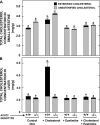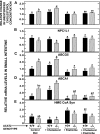Multiple mechanisms limit the accumulation of unesterified cholesterol in the small intestine of mice deficient in both ACAT2 and ABCA1
- PMID: 20724527
- PMCID: PMC2993165
- DOI: 10.1152/ajpgi.00190.2010
Multiple mechanisms limit the accumulation of unesterified cholesterol in the small intestine of mice deficient in both ACAT2 and ABCA1
Abstract
Cholesterol homeostasis in the enterocyte is regulated by the interplay of multiple genes that ultimately determines the net amount of cholesterol reaching the circulation from the small intestine. The effect of deleting these genes, particularly acyl CoA:cholesterol acyl transferase 2 (ACAT2), on cholesterol absorption and fecal sterol excretion is well documented. We also know that the intestinal mRNA level for adenosine triphosphate-binding cassette transporter A1 (ABCA1) increases in Acat2(-/-) mice. However, none of these studies has specifically addressed how ACAT2 deficiency impacts the relative proportions of esterified and unesterified cholesterol (UC) in the enterocyte and whether the concurrent loss of ABCA1 might result in a marked buildup of UC. Therefore, the present studies measured the expression of numerous genes and related metabolic parameters in the intestine and liver of ACAT2-deficient mice fed diets containing either added cholesterol or ezetimibe, a selective sterol absorption inhibitor. Cholesterol feeding raised the concentration of UC in the small intestine, and this was accompanied by a significant reduction in the relative mRNA level for Niemann-Pick C1-like 1 (NPC1L1) and an increase in the mRNA level for both ABCA1 and ABCG5/8. All these changes were reversed by ezetimibe. When mice deficient in both ACAT2 and ABCA1 were fed a high-cholesterol diet, the increase in intestinal UC levels was no greater than it was in mice lacking only ACAT2. This resulted from a combination of compensatory mechanisms including diminished NPC1L1-mediated cholesterol uptake, increased cholesterol efflux via ABCG5/8, and possibly rapid cell turnover.
Figures






Similar articles
-
ACAT2 and ABCG5/G8 are both required for efficient cholesterol absorption in mice: evidence from thoracic lymph duct cannulation.J Lipid Res. 2012 Aug;53(8):1598-609. doi: 10.1194/jlr.M026823. Epub 2012 Jun 5. J Lipid Res. 2012. PMID: 22669916 Free PMC article.
-
ACAT2 deficiency limits cholesterol absorption in the cholesterol-fed mouse: impact on hepatic cholesterol homeostasis.Hepatology. 2004 Nov;40(5):1088-97. doi: 10.1002/hep.20439. Hepatology. 2004. PMID: 15486928
-
Intestinal cholesterol absorption is substantially reduced in mice deficient in both ABCA1 and ACAT2.J Lipid Res. 2005 Nov;46(11):2423-31. doi: 10.1194/jlr.M500232-JLR200. Epub 2005 Sep 8. J Lipid Res. 2005. PMID: 16150828
-
Sterol transporters: targets of natural sterols and new lipid lowering drugs.Pharmacol Ther. 2005 Mar;105(3):333-41. doi: 10.1016/j.pharmthera.2004.10.011. Epub 2004 Dec 9. Pharmacol Ther. 2005. PMID: 15737409 Review.
-
Development and physiological regulation of intestinal lipid absorption. III. Intestinal transporters and cholesterol absorption.Am J Physiol Gastrointest Liver Physiol. 2008 Apr;294(4):G839-43. doi: 10.1152/ajpgi.00061.2008. Epub 2008 Feb 14. Am J Physiol Gastrointest Liver Physiol. 2008. PMID: 18276831 Review.
Cited by
-
Insig proteins mediate feedback inhibition of cholesterol synthesis in the intestine.J Biol Chem. 2014 Jan 24;289(4):2148-56. doi: 10.1074/jbc.M113.524041. Epub 2013 Dec 11. J Biol Chem. 2014. PMID: 24337570 Free PMC article.
-
Ezetimibe markedly attenuates hepatic cholesterol accumulation and improves liver function in the lysosomal acid lipase-deficient mouse, a model for cholesteryl ester storage disease.Biochem Biophys Res Commun. 2014 Jan 17;443(3):1073-7. doi: 10.1016/j.bbrc.2013.12.096. Epub 2013 Dec 25. Biochem Biophys Res Commun. 2014. PMID: 24370824 Free PMC article.
-
Quantitation of the rates of hepatic and intestinal cholesterol synthesis in lysosomal acid lipase-deficient mice before and during treatment with ezetimibe.Biochem Pharmacol. 2017 Jul 1;135:116-125. doi: 10.1016/j.bcp.2017.03.010. Epub 2017 Mar 18. Biochem Pharmacol. 2017. PMID: 28322747 Free PMC article.
-
ACAT2 and ABCG5/G8 are both required for efficient cholesterol absorption in mice: evidence from thoracic lymph duct cannulation.J Lipid Res. 2012 Aug;53(8):1598-609. doi: 10.1194/jlr.M026823. Epub 2012 Jun 5. J Lipid Res. 2012. PMID: 22669916 Free PMC article.
-
Sustained and selective suppression of intestinal cholesterol synthesis by Ro 48-8071, an inhibitor of 2,3-oxidosqualene:lanosterol cyclase, in the BALB/c mouse.Biochem Pharmacol. 2014 Apr 1;88(3):351-63. doi: 10.1016/j.bcp.2014.01.031. Epub 2014 Jan 31. Biochem Pharmacol. 2014. PMID: 24486573 Free PMC article.
References
-
- Alger HM, Brown JM, Sawyer JK, Kelley KL, Shah R, Wilson MD, Willingham MC, Rudel LL. Inhibition of acyl-coenzyme A:cholesterol acyltransferase 2 (ACAT2) prevents dietary cholesterol-associated steatosis by enhancing hepatic triglyceride mobilization. J Biol Chem 285: 14267–14274, 2010 - PMC - PubMed
-
- Bays HE, Neff D, Tomassini JE, Tershakovec AM. Ezetimibe: cholesterol lowering and beyond. Expert Rev Cardiovasc Ther 6: 447–470, 2008 - PubMed
-
- Beltroy EP, Richardson JA, Horton JD, Turley SD, Dietschy JM. Cholesterol accumulation and liver cell death in mice with Niemann-Pick type C disease. Hepatology 42: 886–893, 2005 - PubMed
-
- Buhman KK, Accad M, Novak S, Choi RS, Wong JS, Hamilton RL, Turley SD, Farese RV., Jr Resistance to diet-induced hypercholesterolemia and gallstone formation in ACAT2-deficient mice. Nat Med 6: 1341–1347, 2000 - PubMed
Publication types
MeSH terms
Substances
Grants and funding
LinkOut - more resources
Full Text Sources
Medical
Molecular Biology Databases

